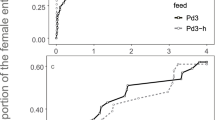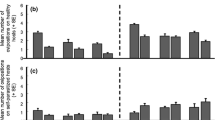Abstract
Patch residence time is at the core of models of decision making by foragers living in patchy environments. We studied patch residence time (PRT) of Ibalia leucospoides, a parasitoid of the woodwasp Sirex noctilio, as assigned to 4 treatments (recent feeding and/or oviposition experience) foraging in an array of host-infested pine logs. We tested the effects of distance from release point, host abundance, and the number of con-specifics at the time of arrival, on patch (pine log) residence time. PRT depended on a combination of patch quality (number of hosts in a log) and distance from the release point. Neither the presence of con-specifics on the patch, prior exposure to hosts, nor feeding prior to the experiment affected the time spent on a patch. We conclude that PRT in I. leucospoides meets Marginal Value Theorem predictions qualitatively, overruling the effects recent oviposition experience, access to food and contact with conspecifics. These findings are in line with the reported pro-ovigeny in I. leucospoides as well as the strong spatial aggregation of hosts in the field.


Similar content being viewed by others
References
Beddington JR (1975) Mutual interference between parasites or predators and its effect on searching efficiency. J Anim Ecol 44:331–340
Bernstein C, Jervis M (2008) Food searching in parasitoids: the dilemma of choosing between immediate or future gains. In: Wajnberg E, Bernstein C, van Alphen JJM (eds) Behavioural ecology of insect parasitoids. From theoretical approaches to field applications. Blackwell Science, Oxford, pp 129–171
Bianchi FJJA, Wäckers FL (2008) Effects of flower attractiveness and nectar availability in field margins on biological control by parasitoids. Biol Control 46:400–408
Charnov EL (1976) Optimal foraging: the marginal value theorem. Theo Pop Biol 9:129–136
Corley JC, Bruzzone OA (2009) Delayed emergence and the success of parasitoids in biological control. Biol Control 51:471–474
Corley JC, Capurro AF, Bernstein C (2004) Prolonged diapause and the stability of host-parasitoid interactions. Theo Pop Biol 65:193–203
Corley JC, Villacide JM, Bruzzone OA (2007) Spatial dynamics of a Sirex noctilio woodwasp population within a pine plantation in Patagonia, Argentina. Entomol Exper et App 15:231–236
Coutts MP (1969) The mechanism of pathogenicity of Sirex noctilio on Pinus radiata. I. Effects of the symbiotic fungus Amylostereum sp. (Thelophoraceae). Aust J Biol Sci 22:915–924
Crawley MJ (1993) Glim for ecologists. Blackwell Science, Oxford, p 304
Cronin JT, Strong DR (1999) Dispersal-dependent oviposition and the aggregation of parasitism. Am Nat 154(1):23–36
R Development Core Team (2008) R: A language and environment for statistical computing. R Foundation for Statistical Computing, Vienna, Austria. ISBN 3-900051-07-0, URL http://www.R-project.org
Fernández-Arhex V, Corley JC (2005) The functional response of Ibalia leucospoides Hochenwarth (Hymenoptera: Ibaliidae), a parasitoid of Sirex noctilio (Hymenoptera: Siricidae). Relating host encounter success with the response. Biocontrol Sci Tech 15:1–6
Fernández-Arhex V, Corley JC (2010) The effects of patch richness on con-specific interference in the parasitoid Ibalia leucospoides (Hymenoptera, Ibaliidae) Insect Sci., in press
Goubault M, Outreman Y, Poinsot D, Cortesero AM (2005) Patch exploitation strategies of parasitic wasps under intraspecific competition. Behav Ecol 16:693–701
Goubault M, Mack AFS, Hardy ICW (2007) Encountering competitors reduces clutch size and increases offspring size in a parasitoid with female-female fighting. Proc Royal Soc B 274:2571–2577
Greathead D, Greathead AH (1992) Biological control of insect pests by parasitoids and predators: the BIOCAT database. Biocontrol N Inform 13:61–68
Hassell MP (2000) The spatial and temporal dynamics of host–parasitoid interactions. Oxford University Press, Oxford
Haugen DA, Underdowm MG (1993) Reduced parasitism of Sirex noctilio in radiate pines inoculated with the nematode Beddingia siricidicola during 1974–1989. Aust Forest 56:45–48
Hawkins BA (1994) Pattern and process in host-parasitoid interactions. Cambridge University Press, 190 pp.
Hoebeke ER, Haugen DA, Haack RA (2005) Sirex noctilio: Discovery of a palearctic siricid woodwasp in New York. Newsletter Michigan Entomol Soc 50:24–25
Humphries EL, Hebblethwaite AJ, Batchelor TP, Hardy ICW (2006) The importance of valuing resources: host weight and contender age as determinants of parasitoid wasp contest outcomes. Anim Behav 72:891–898
Hurley BP, Slippers B, Wingfield MJ (2007) A comparison of control results for the alien invasive woodwasp, Sirex noctilio, in the southern hemisphere. Agri For Entomol 9:159–171
Jervis MA, Ellers J, Harvey JA (2008) Resource acquisition, allocation, and utilization in parasitoid reproductive strategies. Ann Rev Entomol 53:361–385
Kacelnik A (1984) Central place foraging in starlings (Sturnus vulgaris). I. Patch residence time. J Anim Ecol 53:283–299
Kidd N, Jervis M (1996) Populations dynamics. In: Kidd N, Jervis M (eds) Insect natural enemies. Practical approaches to their study and evaluation. Chapman and Hall, UK, pp 21–284
Klasmer P, Fritz G, Botto E, Corley JC (1997) Current status of research on Sirex noctilio in the Andean Patagonia region (Argentina). In: Iede ET, Schaitza E, Penteado S., Reardon R., Murphy ST (eds) Proceedings of the training workshop for the control of Sirex noctilio by natural enemies. Forest Health Technology Enterprise Team 98–13, USA, pp 98–90
Lair H, Kramer DL, Giraldeau LA (1984) Interference competition in central place foragers: the effect of imposed waiting on patch use decisions of eastern chipmunks. Behav Ecol 5:237–244
Madden JL (1968) Behavioural responses of parasites to the symbiotic fungus associated with Sirex noctilio F. Nature 218:189–190
Madden JL (1988) Sirex in Australasia. In: Berryman AA (ed) Dynamics of forest insect populations: patterns, causes and implications. Plenum Press, pp 407-429
Martinez A, Fernández-Arhex V, Corley JC (2006) Chemical information from the fungus Amylostereum areolatum and host-foraging behaviour in the parasitoid Ibalia leucospoides. Phys Entomol 31:1–5
Mills NJ, Wajnberg E (2008) Optimal foraging behaviour and efficient biological control. In: Wajnberg E, Bernstein C, van Alphen JJM (eds) Behavioral ecology of insect parasitoids from theoretical approaches to field applications. Blackwell Science, Oxford, pp 3–30
Mitchell WA, Abramsky Z, Kotler BP, Pinshow B, Brown JS (1990) The effect of competition on foraging activity in desert rodents: theory and experiments. Ecology 71(3):844–854
Neuman FG, Minko G (1981) The Sirex woodwasp in Australian radiata pine plantations. Aust Forest 44:46–63
Smid HM, Wang G, Bukovinszky T, Steidle JLM, Bleeker MAK, van Loon JJA, Vet LEM (2007) Species-specific acquisition and consolidation of long-term memory in parasitic wasps. Proc Royal Soc B 274:1539
Spradbery JP (1977) The oviposition biology of siricid woodwasps in Europe. Ecol Entomol 2:224–230
Stephens DW, Charnov EL (1982) Optimal foraging: Some simple stochastic models. Behav Ecol Sociobiol 10(4):251–263
Stephens DW, Krebs JR (1986) Foraging theory. Princeton University Press, Princeton
Taylor KL (1978) Evaluation of the insects parasitoids of Sirex noctilio (Hymenoptera: Siricidae) in Tasmania. Oecologia 32:1–10
Tentelier C, Desouhant E, Fauvergue X (2006) Habitat assessment by parasitoids: mechanisms for patch use behaviour. Behav Ecol 17:515–521
Thiel A, Hoffmeister T (2004) Knowing your habitat: linking patch-encounter rate and patch exploitation in parasitoids. Behav Ecol 15:419–25
Turlings TCJ, Wäckers FL, Vet LEM, Lewis WJ, Tumlinson JH (1993) Learning of host-finding cues by hymenopterous parasitoides. In: Papaj DR, Lewis AC (eds) Insect learning: ecological and evolutionary perspectives. Chapman and Hall, New York, pp 51–78
van Alphen JJM (1988) Patch-time allocation by insect parasitoids: superparasitism and aggregation. In: de Jong G (ed) Population genetics and evolution. Springer-Verlag, Berlin, pp 216–221
van Alphen and Vet LEM (1986) An evolutionary approach to host finding and selection. In: Waage J, Greathead D (eds) Insect parasitoids, 3th Symposium of Royal Entomological Society of London. Academic Press, London, pp. 23–611.
van Alphen JJM, Bernstein C (2008) Information acquisition, information processing and patch time allocation in insect parasitoids. In: Wajnberg E, Bernstein C, van Alphen JJM (eds) Behavioral ecology of insect parasitoids. Ffrom theoretical approaches to field applications. Blackwell Science, Oxford, pp 172–192
van Nouhuys S, Kaartinen R (2008) A parasitoid wasp uses landmarks while monitoring potential resources. Proc Royal Soc B 275:377–385
Vet LEM, Lewis WJ, Cardé RT (1995) Parasitoid foraging and learning. In: Bell W, Cardé RT (eds) Chemical ecology of insects. Chapman and Hall, New York, pp 65–101
Visser ME, Van Alphen JJM, Nell HW (1990) Adaptive superparasitism and patch time. Behaviour 114:21–36
Wajnberg E (2006) Time allocation strategies in insect parasitoids: from ultimate predictions to proximate behavioral mechanisms. Behav Ecol Sociobiol 60:589–611
Winkler K, Wäckers F, Bukovinszkine-Kiss G, van Lenteren J (2006) Sugar resources are vital for Diadegma semiclausum fecundity under field conditions. Basic Appl Ecol 7:133
Acknowledgments
This work was carried out within the Finland-Argentina Research exchange program Grant FI/A03/B01. We also acknowledge financial support from ANPCyT, Argentina (PICT 0-1200/06) and PICS 4144 (CNRS) and The Academy of Finland Centre of Excellence program (grant no. 20286). E. Desouhant and D. Fischbein provided significant advice on the experiments and data analysis.
Author information
Authors and Affiliations
Corresponding author
Electronic supplementary material
Below is the link to the electronic supplementary material.
Table S1
(DOC 67 kb)
Rights and permissions
About this article
Cite this article
Corley, J.C., Villacide, J.M. & van Nouhuys, S. Patch Time Allocation by a Parasitoid: The Influence of Con-specifics, Host Abundance and Distance to the Patch. J Insect Behav 23, 431–440 (2010). https://doi.org/10.1007/s10905-010-9226-8
Revised:
Accepted:
Published:
Issue Date:
DOI: https://doi.org/10.1007/s10905-010-9226-8




